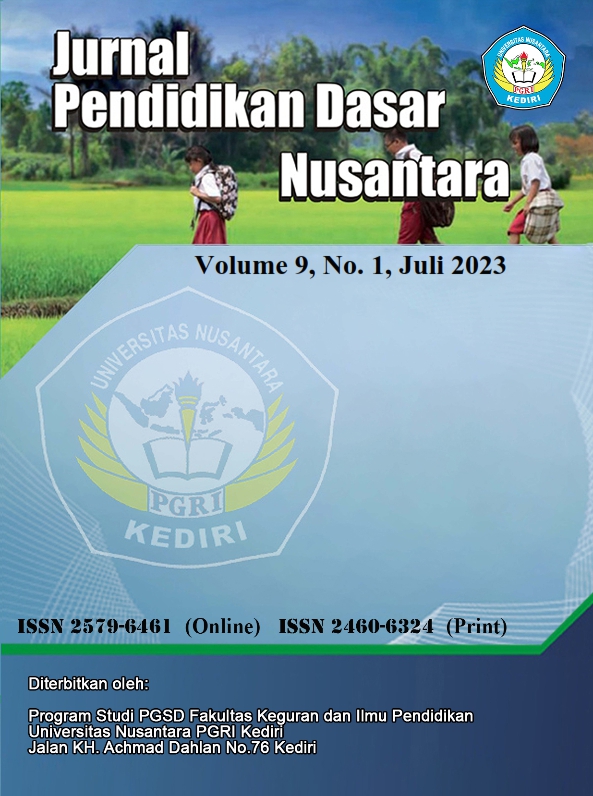Implementation of the independent curriculum for students with special needs at SDN Gadang 03 Malang City
DOI:
https://doi.org/10.29407/jpdn.v9i1.20445Keywords:
implementation, teaching modules, independent curriculumAbstract
The purpose of this study was to find out how the independent curriculum was implemented for students with special needs at SD Gadang 3 Malang City as well as the types of children with special needs within it. Data collection techniques used in this study include interviews, observations, and documentation. The subjects of this research are 5th-grade teachers who also handle students with special needs, the school principal, and the students with special needs themselves. Data analysis techniques used are data collection, data reduction, data display, and verification. The results of this study indicated that the implementation of the independent curriculum for students with special needs at SDN Gadang 3 is packaged in a simple and detailed manner. So both regular and those with special needs, can effectively and maximally absorb the delivered material. There is no specific strategy in the learning process, it's just that the method of delivery uses diction that is easy to understand. The use of teaching modules in the learning process is also generalized to other students. The process of assessing learning outcomes is obtained from the mid-semester and final-semester examinations provided by the GPK team in their respective cities.
Downloads
References
A’yun, Syifa Qurrota;, and Eva Latipah. 2022. “Upaya Guru Dalam Identifikasi Siswa Disleksia.” Koloni 1(2):469–77.
Amanulla, Akhmad Syah Roni. 2022. “Mengenal Anak Berkebutuhan Khusus: Tuna Grahita, Down Syndrom Dan Autisme.” Al-Murtaja: Jurnal Pendidikan Islam Anak Usia Dini 1(1):1–13.
Aurelia, Terra, Nan Rahminawati, and Dinar Nur Inten. 2022. “Analisis Faktor Internal Dan Faktor Eksternal Yang Mempengaruhi Keterlambatan Bicara (Speech Delay) Anak Usia 5,9 Tahun.” Bandung Conference Series: Early Childhood Teacher Education 2(2):69–78. doi: 10.29313/bcsecte.v2i2.3504.
Dwi, Arip, and Dwi Setianingsih. 2019. “Efektivitas Multimedia Interaktif Berbasis Saintifik Dalam Meningkatkan Prestasi Belajar Siswa Di SD Inklusif.” JPI (Jurnal Pendidikan Inklusi) 3(1):53. doi: 10.26740/inklusi.v3n1.p53-59.
Fauzia, Wulan & Meiliawati, Fithri et al. 2020. “Jurnal Al-Shifa Volume 1 No 2, 2020.” Jurnal Al-Shifa 1(2):102–10.
Lafiana, N. A., H. Witono, and L. H. Affandi. 2022. “Problematika Guru Dalam Membelajarkan Anak Berkebutuhan Khusus.” Journal of Classroom Action … 4(2). doi: 10.29303/jcar.v4i1.1686.
Lalak Muslimin, Luk Luk Yata, and Muqowim Muqowim. 2021. “Peran Kepala Sekolah Terhadap Kebijakan Pendidikan Inklusi Di Tingkat Sekolah Dasar.” Jurnal Kependidikan: Jurnal Hasil Penelitian Dan Kajian Kepustakaan Di Bidang Pendidikan, Pengajaran Dan Pembelajaran 7(3):708. doi: 10.33394/jk.v7i3.3468.
Lestari, Sri Inda, Pendidikan Islam, Anak Usia, Universitas Al-washliyah Univa Medan, Pendidikan Islam, and Anak Usia. 2023. “Perilaku Anak Autis : Perkembangan Dan Penangan.” 5:150–55.
Marwiyati, Sri, and Asrie Sekar Kinasih. 2022. “Shadow Teacher Dalam Proses Pembelajaran Anak Usia Dini Di Lembaga Raudlatul Athfal.” Journal of Early Childhood and Character Education 2(1):29–46. doi: 10.21580/joecce.v2i1.10674.
Ni’mah, Nia Uzlifatun, Adinda Nur Istirohmah, Hamidaturrohmah, and Aan Widiyono. 2022. “Problematika Penyelenggara Pendidikan Inklusi Di Sekolah Dasar.” Jote 3(3):345–53.
Ningrum, Nila Ainu. 2022. “Strategi Pembelajaranpada AnakBerkebutuhan Khusus Dalam Pendidikan Inklusi.” Indonesian Journal of Humanities and Social Sciences 3(3):181–96.
Nurfadhillah, Septy, Aisah Nur Fitri, Dyah Utami, Faradya Navyanti, Ghina Salsabila J, Laysia Ustianingsih, Nurul Izzah, and Reny Rahma Amalia. 2022. “Pendidikan Inklusi Dengan Anak Penyandang Ketunaan Slow Learner (Lambat Belajar) Dan CIBI (Cerdas Istimewa, Berbakat Istimewa).” Alsys 2(1):84–94. doi: 10.58578/alsys.v2i1.144.
Nurfadhillah, Septy, Alviani Saridevita, Aris Setiawan Adji, Febi Ria Valentina, Herlin Wizy Astuty, Nanda Devita, Sagita Destiyantari, and Universitas Muhammadiyah Tangerang. 2022. “Analisis Kesulitan Belajar Membaca (Disleksia) Dan Kesulitan Belajar Menulis (Disgrafia)Siswa Kelas I Sdn Tanah Tinggi 3 Tangerang.” MASALIQ : Jurnal Pendidikan Dan Sains 2(1):114–22.
Safitri, D., and Y. S. Hijriyani. 2021. “Pendidikan Inklusif Sebagai Strategi Mewujudkan Pendidikan Menyeluruh Bagi Anak Usia Dini.” … Islam Anak Usia Dini IAIN … 27–39.
Safitri, Fika, Faris Naufal Ali, and Eva Latipah. 2022. “Ketidakmampuan Membaca (Disleksia) Dan Dampaknya Terhadap Perkembangan Anak.” WASIS : Jurnal Ilmiah Pendidikan 3(1):37–44. doi: 10.24176/wasis.v3i1.7713.
Suriadi, S., and M. Mursidin. 2020. “Jurnal Al – Qiyam.” Qiyam, Jurnal Al 1(2):11–20.
Syaputri, Echa, and Rodia Afriza. 2022. “Peran Orang Tua Dalam Tumbuh Kembang Anak Berkebutuhan Khusus (Autisme).” Educativo: Jurnal Pendidikan 1(2):559–64. doi: 10.56248/educativo.v1i2.78.
Tyas Pratiwi, Laura, Meilani Nur Maghfiroh, Dimas Septa Andika, Intan Nur Marcela, and Awayna Faza Afifah. 2022. “Permasalahan Yang Dihadapi Dalam Pelaksanaan Sekolah Inklusi Di Indonesia.” Jurnal Pendidikan Dasar Flobamorata 3(2):314–18. doi: 10.51494/jpdf.v3i2.704.
Yunita, Evi Isna, Sri Suneki, and Husni Wakhyudin. 2019. “Manajemen Pendidikan Inklusi Dalam Proses Pembelajaran Dan Penanganan Guru Terhadap Anak Berkebutuhan Khusus.” International Journal of Elementary Education 3(3):267. doi: 10.23887/ijee.v3i3.19407.
Downloads
Published
Issue
Section
License
Authors who publish with this journal agree to the following terms:
- Copyright on any article is retained by the author(s).
- The author grants the journal, the right of first publication with the work simultaneously licensed under a Creative Commons Attribution License that allows others to share the work with an acknowledgment of the work’s authorship and initial publication in this journal.
- Authors are able to enter into separate, additional contractual arrangements for the non-exclusive distribution of the journal’s published version of the work (e.g., post it to an institutional repository or publish it in a book), with an acknowledgment of its initial publication in this journal.
- Authors are permitted and encouraged to post their work online (e.g., in institutional repositories or on their website) prior to and during the submission process, as it can lead to productive exchanges, as well as earlier and greater citation of published work.
- The article and any associated published material is distributed under the Creative Commons Attribution-ShareAlike 4.0 International License

































